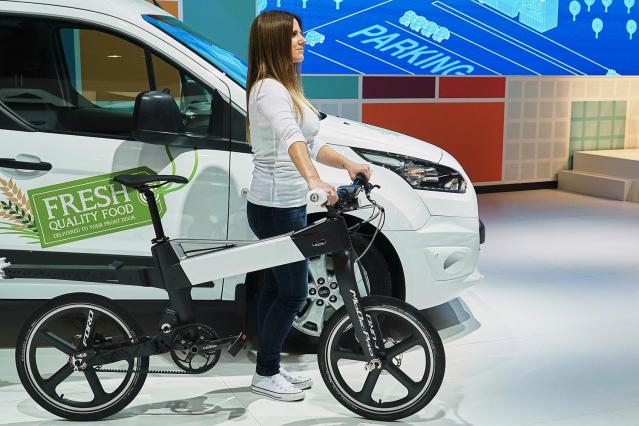Big companies love acronyms, and Ford is no exception. It calls the MoDe: Pro a “commercial multi-modal transport system,” but we prefer “e-bike.” The result of an internal design competition at Ford, the electric two-wheeler made a strange standout alongside smartphones and wearables at Mobile World Congress this week, but it’s designed to work in concert with both.
A 200w motor enables the MoDe: Pro to hit speeds of up to 15 miles per hour, and the 9 Ah battery gives it an hour and a half of continuous use, but it’s really designed to run in spurts when you need it. That’s where the mobile synergy comes into play. If you pair the bike with a heart-rate sensor, the motor can be configured to kick in when your heart rate reaches a certain level. In other words, it recognizes when you’re working hard and provides a little extra help.
You can also use the voice-activated app to check the charge on the bike and access stats. The same app enables bike tracking, route-planning, and delivery scheduling. That’s because Ford sees this as a commercial fleet product that you tote around inside a van, and then deploy at a destination. It can be folded up and docked in the van, which automatically charges the battery, and modular boxes on the tail-rack offer ample storage space. When folded, it can also be towed like a wagon for rolling through pedestrianized areas, or inside buildings. Ford expects it will appeal to delivery services, tradesmen, couriers, and even municipal services like the police.

The cool features continue with the navigation system, which is powered by your linked smartphone. The handlebars provide cues. For example, when you need to turn right, the right handlebar vibrates, and there are turn signals on the end of each handlebar. There’s also a proximity sensor, so both handlebars will vibrate to alert the rider that a vehicle is close behind them, or is overtaking.
A headlight improves visibility, and a strobe mode can be used for emergencies. The horn has two tones: one gentle one for pedestrians, and a louder one for traffic.
Ford is looking for customer feedback right now, which the company will use to further shape the final e-bike. It’s unlikely we’ll be seeing this on the roads before the year is out. There’s no word on pricing or on the possibility of a consumer version, but we’ll be sure to track its progress.



